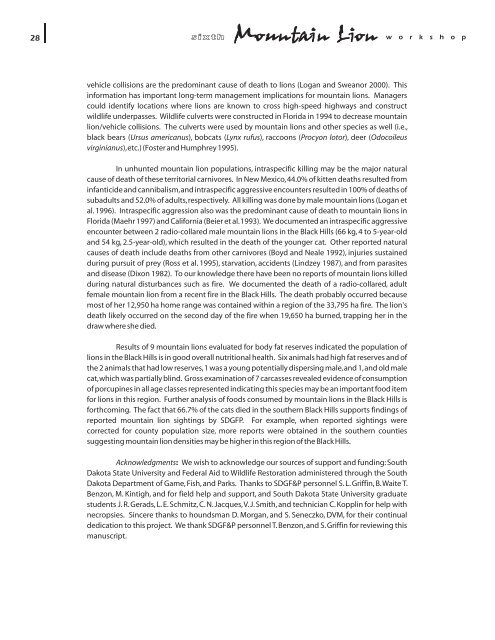PWD BK W7000-893 Proceedings.CDR - Mountain Lion Foundation
PWD BK W7000-893 Proceedings.CDR - Mountain Lion Foundation
PWD BK W7000-893 Proceedings.CDR - Mountain Lion Foundation
Create successful ePaper yourself
Turn your PDF publications into a flip-book with our unique Google optimized e-Paper software.
28<br />
sixth <strong>Mountain</strong> <strong>Lion</strong> w o r k s h o p<br />
vehicle collisions are the predominant cause of death to lions (Logan and Sweanor 2000). This<br />
information has important long-term management implications for mountain lions. Managers<br />
could identify locations where lions are known to cross high-speed highways and construct<br />
wildlife underpasses. Wildlife culverts were constructed in Florida in 1994 to decrease mountain<br />
lion/vehicle collisions. The culverts were used by mountain lions and other species as well (i.e.,<br />
black bears ( Ursus americanus), bobcats ( Lynx rufus), raccoons ( Procyon lotor), deer ( Odocoileus<br />
virginianus),etc.)<br />
(Foster and Humphrey 1995).<br />
In unhunted mountain lion populations, intraspecific killing may be the major natural<br />
cause of death of these territorial carnivores. In New Mexico,44.0% of kitten deaths resulted from<br />
infanticide and cannibalism,and intraspecific aggressive encounters resulted in 100% of deaths of<br />
subadults and 52.0% of adults,respectively. All killing was done by male mountain lions (Logan et<br />
al. 1996). Intraspecific aggression also was the predominant cause of death to mountain lions in<br />
Florida (Maehr 1997) and California (Beier et al.1993). We documented an intraspecific aggressive<br />
encounter between 2 radio-collared male mountain lions in the Black Hills (66 kg, 4 to 5-year-old<br />
and 54 kg, 2.5-year-old), which resulted in the death of the younger cat. Other reported natural<br />
causes of death include deaths from other carnivores (Boyd and Neale 1992), injuries sustained<br />
during pursuit of prey (Ross et al. 1995), starvation, accidents (Lindzey 1987), and from parasites<br />
and disease (Dixon 1982). To our knowledge there have been no reports of mountain lions killed<br />
during natural disturbances such as fire. We documented the death of a radio-collared, adult<br />
female mountain lion from a recent fire in the Black Hills. The death probably occurred because<br />
most of her 12,950 ha home range was contained within a region of the 33,795 ha fire. The lion's<br />
death likely occurred on the second day of the fire when 19,650 ha burned, trapping her in the<br />
draw where she died.<br />
Results of 9 mountain lions evaluated for body fat reserves indicated the population of<br />
lions in the Black Hills is in good overall nutritional health. Six animals had high fat reserves and of<br />
the 2 animals that had low reserves,1 was a young potentially dispersing male,and 1,and old male<br />
cat,which was partially blind. Gross examination of 7 carcasses revealed evidence of consumption<br />
of porcupines in all age classes represented indicating this species may be an important food item<br />
for lions in this region. Further analysis of foods consumed by mountain lions in the Black Hills is<br />
forthcoming. The fact that 66.7% of the cats died in the southern Black Hills supports findings of<br />
reported mountain lion sightings by SDGFP. For example, when reported sightings were<br />
corrected for county population size, more reports were obtained in the southern counties<br />
suggesting mountain lion densities may be higher in this region of the Black Hills.<br />
Acknowledgments: We wish to acknowledge our sources of support and funding: South<br />
Dakota State University and Federal Aid to Wildlife Restoration administered through the South<br />
Dakota Department of Game, Fish, and Parks. Thanks to SDGF&P personnel S. L. Griffin, B.Waite T.<br />
Benzon, M. Kintigh, and for field help and support, and South Dakota State University graduate<br />
students J. R. Gerads, L. E. Schmitz, C. N. Jacques,V. J. Smith, and technician C. Kopplin for help with<br />
necropsies. Sincere thanks to houndsman D. Morgan, and S. Seneczko, DVM, for their continual<br />
dedication to this project. We thank SDGF&P personnel T.Benzon, and S.Griffin for reviewing this<br />
manuscript.
















